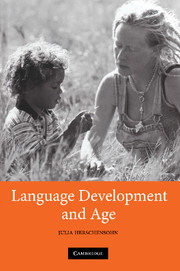Description
Language Development and Age
Author: Herschensohn Julia
This book presents an examination of whether early childhood is a critical period for language acquisition.
Language: English
Subject for Language Development and Age:
Language Development and Age
Publication date: 07-2012
Support: Print on demand
Publication date: 07-2012
Support: Print on demand
Language development and age
Publication date: 10-2007
304 p. · 15.2x22.9 cm · Hardback
Publication date: 10-2007
304 p. · 15.2x22.9 cm · Hardback
Description
/li>Contents
/li>
The anecdotal view of language acquisition is that children learn language with apparent ease, no instruction and in very little time, while adults find learning a new language to be cognitively challenging, labour intensive and time-consuming. In this book Herschensohn examines whether early childhood is a critical period for language acquisition after which individuals cannot learn a language as native speakers. She argues that a first language is largely susceptible to age constraints, showing major deficits past the age of twelve. Second-language acquisition also shows age effects, but with a range of individual differences. The competence of expert adult learners, the unequal achievements of child learners of second languages, and the lack of consistent evidence for a maturational cut-off, all cast doubt on a critical period for second-language acquisition.
1. Just in time: is there a critical period for language acquisition?; 2. Right on time: process and schedule of first language acquisition; 3. All in good time: a window of opportunity for first language acquisition; 4. Behind time: process and schedule of second language acquisition; 5. Pressed for time: age constraints in second language acquisition; 6. Biding time: further consideration of age and acquisition; 7. It's about time: evaluation of age sensitivity in language acquisition.
© 2024 LAVOISIER S.A.S.




